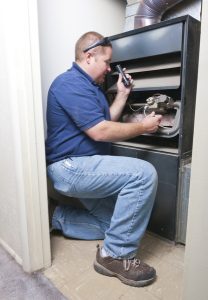
This is no time of the year to be stuck without a fully effective heating system—but if you’ve come across this blog post, it probably means you’re in need of one, now. We get it—you want to just go out and get the first one you can find and put it in, but you shouldn’t purchase just any system nor should you rush a furnace installation. Why?
Well, there are a number of reasons. There is a great deal of work that goes into furnace installation, and a job done right not only keeps you comfortable and impacts the effectiveness of your heater, but it also protects your safety. Keep reading as we go over the steps our techs go through during your furnace installation. Then, you’ll understand why you need a trained and experienced professional for the job.
Step 1: Removing the Furnace
Removing a furnace sounds easy enough, right? Actually, you might be surprised that this is actually the most important, and the most laborious, part of the job. It’s about more than simply pulling out the heater and throwing it a dumpster (don’t do this, by the way—it must be properly disposed of). If the system is a gas-powered one, our pros have to make sure nothing is damaged or out of place before putting in a new heater.
We need to make sure there is adequate space for your new heating system, and the space left must be adequately prepared for the placement of a new furnace. Potential safety concerns must be eliminated, and we have to ensure that your new furnace is appropriately sized for your living space—too big of a heater will be just as detrimental as too small of one.
Step 2: Making the Connections
One your new furnace is placed where it’s meant to be—and this usually means bolting it to the floor—our technicians will connect it to the important components of your home so that it can operate.
This includes one very important part of your HVAC system—the ventilation. Your air ducts must be properly connected to the furnace without causing any damage. Because the ducts often have to be shifted and adjusted to make these connections, mistakes can happen, and furnace efficiency can suffer due to damage.
Next, we connect your furnace to its intended power source. As we referenced in step 1, making the connection to your gas line is a job that has to be done very carefully. Then comes the wiring connection. Even gas-powered systems have some electrical components, so this is necessary no matter what type of furnace you have.
Step 3: Testing Your New Heater
This is the last step, but also very important. If our techs left your home after making that last connection without testing your furnace, you would have no way of knowing if it can perform efficiently as it’s designed to, or even as safely as it’s meant to!
Our technicians will turn on your furnace and measure the intake and airflow to ensure that the performance of your new furnace is efficient, and we’ll make sure there are no potential hazards.
When you’re looking for professional furnace installation in Maumee, OH, reach out to AW Heating & Cooling—Your Comfort Specialists!
